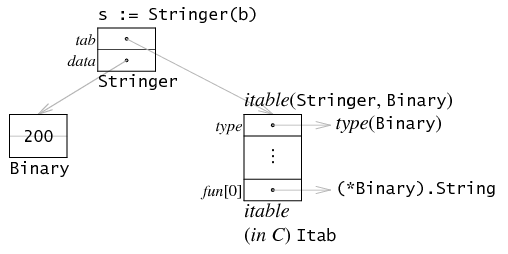 在这篇文章中我们将学习“Golang里面的Interface有什么作用?”的相关知识,下文有详细的介绍及实例,步骤过程清晰,简单易懂,小编觉得挺不错的,有需要的朋友可以借鉴参考,希望大家阅读完这篇能有所获。
在这篇文章中我们将学习“Golang里面的Interface有什么作用?”的相关知识,下文有详细的介绍及实例,步骤过程清晰,简单易懂,小编觉得挺不错的,有需要的朋友可以借鉴参考,希望大家阅读完这篇能有所获。背景:
golang的interface是一种satisfied式的。A类只要实现了IA interface定义的方法,A就satisfied了接口IA。更抽象一层,如果某些设计上需要一些更抽象的共性,比如print各类型,这时需要使用reflect机制,reflect实质上就是将interface的实现暴露了一部分给应用代码。要理解reflect,需要深入了解interface。go的interface是一种隐式的interface,但golang的类型是编译阶段定的,是static的,如:
type MyInt int var i int var j MyInt
虽然MyInt底层就是int,但在编译器角度看,i的类型是int,j的类型是MyInt,是静态、不一致的。两者要赋值必须要进行类型转换。即使是interface,就语言角度来看也是静态的。如:
var r io.Reader
不管r后面用什么来初始化,它的类型总是io.Reader。更进一步,对于空的interface,也是如此。记住go语言类型是静态这一点,对于理解interface/reflect很重要。看一例:
var r io.Reader
tty, err := os.OpenFile("/dev/tty", os.O_RDWR, 0)
if err != nil {
return nil, err
}
r = tty
到这里,r的类型是什么?r的类型仍然是interface io.Reader,只是r = tty这一句,隐含了一个类型转换,将tty转成了io.Reader。
interface的实现:
作为一门编程语言,对方法的处理一般分为两种类型:一是将所有方法组织在一个表格里,静态地调用(C++, java);二是调用时动态查找方法(python, smalltalk, js)。而go语言是两者的结合:虽然有table,但是是需要在运行时计算的table。如下例:Binary类实现了两个方法,String()和Get()
type Binary uint64
func (i Binary) String() string {
return strconv.Uitob64(i.Get(), 2)
}
func (i Binary) Get() uint64 {
return uint64(i)
}
因为它实现了String(),按照golang的隐式方法实现来看,Binary satisfied了Stringer接口。因此它可以赋值: s:=Stringer(b)。以此为例来说明下interface的实现:interface的内存组织如图:

一个interface值由两个指针组成,第一个指向一个interface table,叫 itable。itable开头是一些描述类型的元字段,后面是一串方法。注意这个方法是interface本身的方法,并非其dynamic value(Binary)的方法。即这里只有String()方法,而没有Get方法。但这个方法的实现肯定是具体类的方法,这里就是Binary的方法。
当这个interface无方法时,itable可以省略,直接指向一个type即可。
另一个指针data指向dynamic value的一个拷贝,这里则是b的一份拷贝。也就是,给interface赋值时,会在堆上分配内存,用于存放拷贝的值。
同样,当值本身只有一个字长时,这个指针也可以省略。
一个interface的初始值是两个nil。比如,
var w io.Writer
这时,tab和data都是nil。interface是否为nil取决于itable字段。所以不一定data为nil就是nil,判断时要额外注意。
这样,像这样的代码:
switch v := any.(type) {
case int:
return strconv.Itoa(v)
case float:
return strconv.Ftoa(v, 'g', -1)
}
实际上是any这个interface取了 any. tab->type。
而interface的函数调用实际上就变成了:
s.tab->fun[0](s.data)。第一个参数即自身类型指针。
itable的生成:
itable的生成是理解interface的关键。
如刚开始处提的,为了支持go语言这种接口间仅通过方法来联系的特性,是没有办法像C++一样,在编译时预先生成一个method table的,只能在运行时生成。因此,自然的,所有的实体类型都必须有一个包含此类型所有方法的“类型描述符”(type description structure);而interface类型也同样有一个类似的描述符,包含了所有的方法。
这样,interface赋值时,计算interface对象的itable时,需要对两种类型的方法列表进行遍历对比。如后面代码所示,这种计算只需要进行一次,而且优化成了O(m+n)。
可见,interface与itable之间的关系不是独立的,而是与interface具体的value类型有关。即(interface类型, 具体类型)->itable。
var any interface{} // initialized elsewhere
s := any.(Stringer) // dynamic conversion
for i := 0; i < 100; i++ {
fmt.Println(s.String())
}
itable的计算不需要到函数调用时进行,只需要在interface赋值时进行即可,如上第2行,不需要在第4行进行。
最后,看一些实现代码:
以下是上面图中的两个字段。
type iface struct {
tab *itab // 指南itable
data unsafe.Pointer // 指向真实数据
}
再看itab的实现:
type itab struct {
inter *interfacetype
_type *_type
link *itab
bad int32
unused int32
fun [1]uintptr // variable sized
}
可见,它使用一个疑似链表的东西,可以猜这是用作hash表的拉链。前两个字段应该是用来表达具体的interface类型和实际拥有的值的类型的,即一个itable的key。(上文提到的(interface类型, 具体类型) )
type imethod struct {
name nameOff
ityp typeOff
}
type interfacetype struct {
typ _type
pkgpath name
mhdr []imethod
}
interfacetype如有若干imethod,可以猜想这是表达interface定义的方法数据结构。
type _type struct {
size uintptr
ptrdata uintptr // size of memory prefix holding all pointers
hash uint32
tflag tflag
align uint8
fieldalign uint8
kind uint8
alg *typeAlg
// gcdata stores the GC type data for the garbage collector.
// If the KindGCProg bit is set in kind, gcdata is a GC program.
// Otherwise it is a ptrmask bitmap. See mbitmap.go for details.
gcdata *byte
str nameOff
ptrToThis typeOff
}
对于_type,可见里面有gc的东西,应该就是具体的类型了。这里有个hash字段,itable实现就是挂在一个全局的hash table中。hash时用到了这个字段:
func itabhash(inter *interfacetype, typ *_type) uint32 {
// compiler has provided some good hash codes for us.
h := inter.typ.hash
h += 17 * typ.hash
// TODO(rsc): h += 23 * x.mhash ?
return h % hashSize
}
可见,这里有个把interface类型与具体类型之间的信息结合起来做一个hash的过程,这个hash就是上述的itab的存储地点,itab中的link就是hash中的拉链。
回到itab,看取一个itab的逻辑:
如果发生了typeassert或是interface的赋值(强转),需要临时计算一个itab。这时会先在hash表中找,找不到才会真实计算。
h := itabhash(inter, typ)
// look twice - once without lock, once with.
// common case will be no lock contention.
var m *itab
var locked int
for locked = 0; locked < 2; locked++ {
if locked != 0 {
lock(&ifaceLock)
}
for m = (*itab)(atomic.Loadp(unsafe.Pointer(&hash[h]))); m != nil; m = m.link {
if m.inter == inter && m._type == typ {
return m // 找到了前面计算过的itab
}
}
}
// 没有找到,生成一个,并加入到itab的hash中。
m = (*itab)(persistentalloc(unsafe.Sizeof(itab{})+uintptr(len(inter.mhdr)-1)*sys.PtrSize, 0, &memstats.other_sys))
m.inter = inter
m._type = typ
additab(m, true, canfail)
这个hash是个全局变量:
const (
hashSize = 1009
)
var (
ifaceLock mutex // lock for accessing hash
hash [hashSize]*itab
)
最后,看一下如何生成itab:
// both inter and typ have method sorted by name,
// and interface names are unique,
// so can iterate over both in lock step;
// the loop is O(ni+nt) not O(ni*nt). // 按name排序过的,因此这里的匹配只需要O(ni+nt)
j := 0
for k := 0; k < ni; k++ {
i := &inter.mhdr[k]
itype := inter.typ.typeOff(i.ityp)
name := inter.typ.nameOff(i.name)
iname := name.name()
for ; j < nt; j++ {
t := &xmhdr[j]
tname := typ.nameOff(t.name)
if typ.typeOff(t.mtyp) == itype && tname.name() == iname {
if m != nil {
ifn := typ.textOff(t.ifn)
*(*unsafe.Pointer)(add(unsafe.Pointer(&m.fun[0]), uintptr(k)*sys.PtrSize)) = ifn // 找到匹配,将实际类型的方法填入itab的fun
}
goto nextimethod
}
}
}
nextimethod:
}
h := itabhash(inter, typ) //插入上面的全局hash
m.link = hash[h]
atomicstorep(unsafe.Pointer(&hash[h]), unsafe.Pointer(m))
}
到这里,interface的数据结构的框架。
reflection实质上是将interface背后的实现暴露了一部分给应用代码,使应用程序可以使用interface实现的一些内容。只要理解了interface的实现,reflect就好理解了。如reflect.typeof(i)返回interface i的type,Valueof返回value。
以上就是这篇文章的全部内容了,希望本文的内容对大家的学习或者工作具有一定的参考学习价值,谢谢大家对脚本之家的支持。
以上就是关于“Golang里面的Interface有什么作用?”的相关知识,感谢各位的阅读,想要掌握这篇文章的知识点还需要大家自己动手实践使用过才能领会,如果想了解更多相关内容的文章,欢迎关注群英网络,小编每天都会为大家更新不同的知识。
免责声明:本站发布的内容(图片、视频和文字)以原创、转载和分享为主,文章观点不代表本网站立场,如果涉及侵权请联系站长邮箱:mmqy2019@163.com进行举报,并提供相关证据,查实之后,将立刻删除涉嫌侵权内容。

2022-12-14 11:21:38
2022-08-19 17:53:01
2022-08-19 17:51:59
2022-02-25 17:19:26
2022-01-24 19:23:44
2022-01-04 18:53:44
2022-01-26 18:39:38
2021-11-20 17:46:01
2022-01-18 18:00:09
2022-01-13 18:58:11
2022-01-24 19:23:57
2021-11-22 17:53:55
2021-11-20 17:45:40









